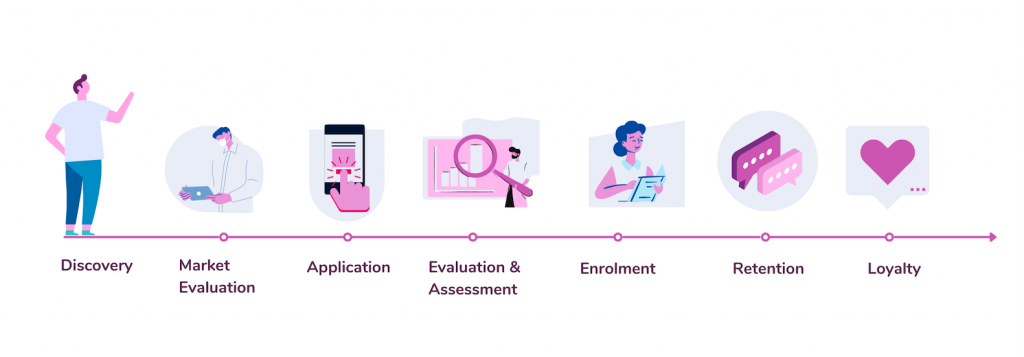Optimise your student’s experience with a journey map

Mapping a student’s journey is the key to ensuring your RTO has deep insights into the student’s experience. From initial contact through the process of various touchpoints, to a long-term relationship with your institution.
Read on to discover journey mapping and how you can use it to identify your student’s experiences and benefit from understanding them better.
What is student journey mapping?
Simply put, a student journey map pinpoints the end-to-end sequence of all interactions between students and RTOs, from the moment they become aware of your RTO to when they’re keeping in touch after graduation.

The use of mapping offers amazing insights into students’ experiences and their fluctuating expectations as they move along their training path. It allows you to define the various feelings, motivations, and expectations your students might have at different stages during the journey.
Journey mapping reflects the student’s minds and helps RTOs understand what students need, how their training processes happen and listing all possible paint points. It also brings a fresh perspective that breaks down the wall between RTOs and their students.
When done correctly, a student journey map is a powerful tool that allows you to identify all key interactions between RTOs and students to ultimately create better experiences moving forward.
Improve student experience and increase enrolments
Having a better understanding of your students leads to insight and a more realistic view of the existing curriculum. It’s crucial to enhance student experiences, and by doing so, increase the enrolment numbers of your institution.
By building a student journey map, you can visualise the underlying causes of various problems related to the curriculum and how they may be affecting students’ experiences.
A student journey map allows RTOs to pay close attention to the students who may need help and identify those who’re just a step away from signing up for a program. It’ll ensure that no student feels lost, frustrated, ignored or leaves with a negative impression of your institution.
Through the students’ journey, we could learn what attracts potential and current students and what drives them away – which ultimately supports your RTO in creating positive changes for the future training path.
Key elements of a student journey map
A student journey can be mapped in any way that suits your RTO. However, a detailed journey usually includes these elements:
- Personas: these are fictional characters – such as age, background, expectations, pain points – that used to describe your students in detail.
- Path: these are the typical steps a student will go through after applying to your RTO.
- Students’ emotions: at this point, you’re expected to conduct in-depth research on students’ experiences and thoughts during their training journeys. This information can be collected through formal or informal interviews, surveys, or feedback forms.
- Touchpoints: these display any point of contact that can be made between the students and your RTO, whether that be application forms on the website, message on social media channels, a click to call moment or a physical visit.
- Gaps and opportunities: once you’ve listed all the elements above, you may want to include these details in your student journey map. This will enable you to identify gaps and areas for improvement and improve students’ experiences in the future.
Putting student at the centre
Every journey map should start with the students. You may discover more by discussing the enrolment process with your current students, surveying those who’ve taken courses at your school, and taking advantage of your website’s digital analytics.

Did your students enjoy their experiences with your RTO? If not, why? What pain points have they experienced? And how could the interaction between them and your school improve?
Asking questions is the most straightforward way to learn about your students’ feelings, thoughts, and expectations. By digging deeper into your students’ minds, you’ll have the most vital information to start mapping your journey.
—
Student journey mapping is essential for your RTO to recruit more students, boost enrolment, and minimise dissatisfaction with your institution’s process and faculties.
When a journey is mapped out and implemented effectively, it can attract students, improve boarding, enrich student life and deliver effective alumni engagement.
Although a student journey map can’t offer a solution to all the challenges facing RTOs, it still could be an important foundation behind the marketing that will help move innovative institutions forward.
The value of mapping a student journey lies in the discoveries, conversations, questions, and insights that come along the way.
